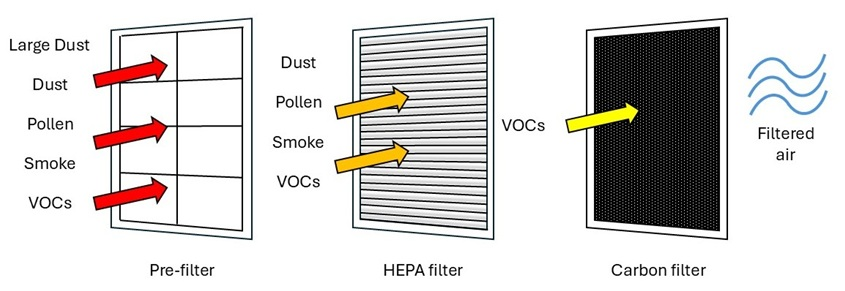Portable air cleaners, also known as air purifiers, are devices that remove air contaminants from indoor air. It’s important to keep indoor air healthy because contaminants in indoor air can cause health effects such as:
- Burning eyes, runny nose, headache, and coughing.
- Aggravation of existing heart and lung diseases, including asthma.
- Mental health concerns and psychological stress.

Choosing a Portable Air Cleaner
Before purchasing, do some research. Start with a list of models that are top-rated or available near you, then consider these four basic criteria.
- Filter Only – No Ionic, Ozone, or Ultraviolet (UV) Technologies
- High Efficiency Particulate Air (HEPA) Filter
- Right Size for Your Room
- Not Too Loud
Learn more about Choosing a Portable Air Cleaner.
Using a Portable Air Cleaner
After choosing a portable air cleaner, learn how to use it so it will work well. Consider where to place it, when to run it, and with which settings. Remember to keep it maintained, including changing filters and other manufacturer recommendations.
Learn more about Using a Portable Air Cleaner.
Other Ways to Improve Indoor Air
A portable air cleaner won’t remove all indoor air pollutants. It’s important to remove sources of contaminants and ventilate when outdoor air quality is good.
- Don’t add to indoor air pollution. Avoid smoking or vaping indoors. Avoid or reduce the use of fragranced products, candles, or incense. Consider frying and broiling less often. Reduce use of sprays, solvents, pesticides, and other VOC-emitting products.
- Clean regularly with damp microfiber cloths and a HEPA-filtering vacuum cleaner. Avoid harsh cleaners.
- Use built-in ventilation like kitchen and bathroom exhaust fans and whole-building ventilation. If you have a stove hood, always use it when cooking.
- Open windows and doors a few times a day. Close them if outdoor fine particulate matter (PM2.5) levels are elevated (Moderate or worse AQI category). You can find this information at AirNow.gov or during wildfire smoke events at the Washington Smoke Information webpage.
- Update your heating, ventilation, and cooling system filters to at least a minimum efficiency reporting value of 13 (MERV 13) or the highest rated filter your system will allow to remove small particles.
- Fix water leaks, wipe up condensation, and manage indoor humidity to prevent mold.
- Install and check carbon monoxide (CO) detectors.
- Test your home for radon.
- Learn more about indoor air quality and healthy homes.
